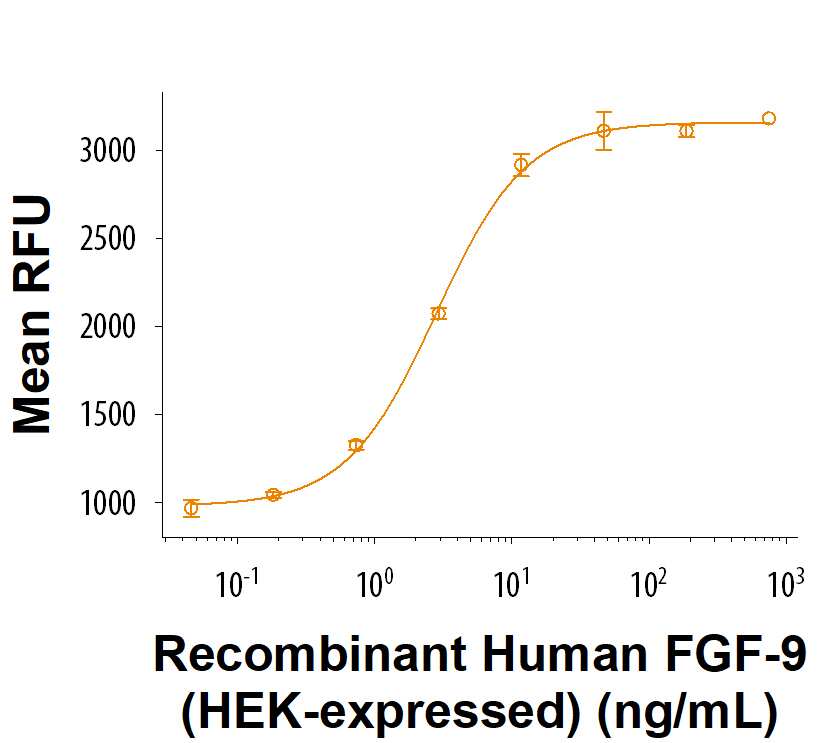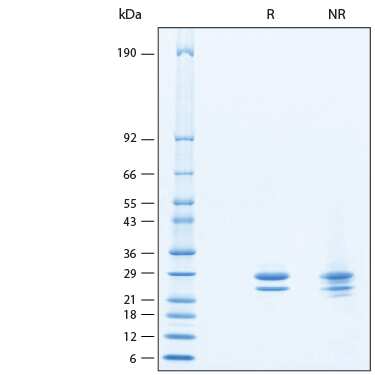Recombinant Human FGF-9 (HEK293-expressed) Protein, CF Summary
Product Specifications
Ala2-Ser208 & Leu4-Ser208
Analysis
Product Datasheets
Carrier Free
CF stands for Carrier Free (CF). We typically add Bovine Serum Albumin (BSA) as a carrier protein to our recombinant proteins. Adding a carrier protein enhances protein stability, increases shelf-life, and allows the recombinant protein to be stored at a more dilute concentration. The carrier free version does not contain BSA.
In general, we advise purchasing the recombinant protein with BSA for use in cell or tissue culture, or as an ELISA standard. In contrast, the carrier free protein is recommended for applications, in which the presence of BSA could interfere.
11233-F9
| Formulation | Lyophilized from a 0.2 μm filtered solution in MOPS, Na2SO4 and EDTA with Trehalose. |
| Reconstitution | Reconstitute at 250 μg/mL in sterile water. |
| Shipping | The product is shipped with polar packs. Upon receipt, store it immediately at the temperature recommended below. |
| Stability & Storage: | Use a manual defrost freezer and avoid repeated freeze-thaw cycles.
|
Scientific Data
 View Larger
View Larger
Measured in a cell proliferation assay using Balb/3T3 Mouse Embryonic Fibroblast cells. Rubin, J.S. et al. (1991) Proc. Natl. Acad. Sci. USA 88:415. The ED50 for this effect is 1.00-5.00 ng/mL.
 View Larger
View Larger
2 μg/lane of Recombinant Human FGF-9 (HEK293-expressed) Protein (Catalog # 11233-F9) was resolved with SDS-PAGE under reducing (R) and non-reducing (NR) conditions and visualized by Coomassie® Blue staining, showing bands at 23-30 kDa.
Reconstitution Calculator
Background: FGF-9
Fibroblast growth factor 9 (FGF-9), also known as HBGF9 and GAF, is a member of the FGF family of secreted glycoproteins involved in mammalian skeleton morphogenesis and growth (1). The FGF family is characterized by a core heparin-binding FGF domain of approximately 120 amino acids (aa) that exhibits a beta -trefoil structure (2). Mature mouse FGF-9 shares 99% and 100% aa sequence identity with human and rat FGF-9, respectively. FGF-9, along with FGF-16 and -20, form a FGF subfamily that shares 65-71% aa sequence identity, binds FGFR3(IIIb), and are efficiently secreted despite having an uncleavable, bipartite signal sequence (2-4). In addition to FGFR3(IIIb), FGF-9 binding to the IIIc splice forms of FGFR-1, -2 and -3 have been reported (1,4,6). In the mouse embryo, the location and timing of FGF-9 expression affects development of the skeleton, cerebellum, lungs, heart, vasculature, digestive tract, and testes (2, 6-11). Deletion of mouse FGF-9 is lethal at birth due to lung hypoplasia, and causes rhizomelia, or shortening of the proximal skeleton (2,10,11). Additionally, a mutation in mouse FGF-9 is responsible for Elbow knee synostosis (Eks), which causes joint fusions in the elbow and knee (6). In humans, FGF9 mutations that lower receptor binding can result multiple synostoses syndrome (SYNS) (7). Altered FGF-9 expression or function is reported in human colon, endometrial, and ovarian cancers, correlating with progression, invasiveness, and survival (12-15).
- Mohammadi, M. et al. (2005) Cytokine Growth Factor Rev. 16:107.
- Itoh, N. and D.M. Ornitz (2008) Dev. Dyn. 237:18.
- Miyamoto, M. et al. (1993) Mol. Cell. Biol. 13:4251.
- Santos-Ocampo, S. et al. (1996) J. Biol. Chem. 271:1726.
- Plotnikov, A.N. et al. (2001) J. Biol. Chem. 276:4322.
- Harada, M. et al. (2009) Nat. Genet. 41:289.
- Wu, X.L. et al. (2009) Am. J. Hum. Genet. 85:53.
- Colvin, J.S. et al. (1999) Dev. Dyn. 216:72.
- Lin, Y. et al. (2009) Dev. Biol. 329:44.
- Hung, I.H. et al. (2007) Dev. Biol. 307:300.
- Colvin, J.S. et al. (2001) Dev. Dyn 128:2095.
- Krejci, P. et al. (2009) Hum. Mutat. 30:1245.
- Leushacke, M. et al. (2011) PLoS ONE 6:e23381.
- Hendrix, N.D. et al. (2006) Cancer Res. 66:1354.
- Abdel-Rahman, W.M. et al. (2008) Hum. Mutat. 29:390.
Citation for Recombinant Human FGF-9 (HEK293-expressed) Protein, CF
R&D Systems personnel manually curate a database that contains references using R&D Systems products. The data collected includes not only links to publications in PubMed, but also provides information about sample types, species, and experimental conditions.
1 Citation: Showing 1 - 1
-
Developmental and hormonal regulation of FBN1 and OR4M1 mRNA in bovine granulosa cells
Authors: Maylem, ERS;Spicer, LJ;Batalha, IM;Sch�tz, LF;
Domestic animal endocrinology
Species: Bovine
Sample Types: Whole Cells
Applications: Bioassay
FAQs
No product specific FAQs exist for this product, however you may
View all Proteins and Enzyme FAQsReviews for Recombinant Human FGF-9 (HEK293-expressed) Protein, CF
There are currently no reviews for this product. Be the first to review Recombinant Human FGF-9 (HEK293-expressed) Protein, CF and earn rewards!
Have you used Recombinant Human FGF-9 (HEK293-expressed) Protein, CF?
Submit a review and receive an Amazon gift card.
$25/€18/£15/$25CAN/¥75 Yuan/¥2500 Yen for a review with an image
$10/€7/£6/$10 CAD/¥70 Yuan/¥1110 Yen for a review without an image
